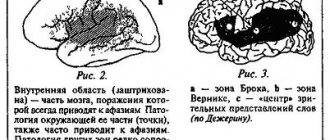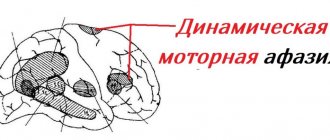Acoustic-gnostic aphasia (Wernicke's aphasia)
At the initial stage, immediately after a stroke or TBI, there is a total loss of the ability to understand spoken speech. Patients perceive words as an incomprehensible set of sounds, sometimes they are not aware of their own speech defect. Psychomotor agitation and logorrhea occur. The subsequent severity of the disorders depends on the severity of the lesion. In a number of cases, partial acoustic-gnostic aphasia is revealed, manifested by the same perception of phonemically similar words (nail-cane-bone) and different understanding of one word (the word “barrel” is sometimes recognized as “kidney”, in other cases as “daughter”). Difficulties in identifying the lexical-semantic part of a word make it difficult to determine its meaning. For example, upon hearing “bell,” the patient understands that we are talking about a small object, but does not determine which one.
Sensory aphasia extends to the perception of one’s own speech, and control of spoken sentences is lost. Literal paraphasia is observed - the replacement of sounds that are phonemically close, but distort the word; verbal paraphasia is the replacement of whole words. The patient’s speech loses its meaning and takes the form of a “speech salad,” which is most typical for the initial period of the disease. Such violations last up to 1.5-2 months. Then logorrhea is noted with numerous agrammatisms, repetitions, and the use of a large number of prepositions. As a result of agnosia, patients do not feel the defect in their speech and are irritable towards the lack of understanding of others. In the recovery period, inconsistency of words in a sentence by gender, number, and the use of pronouns instead of nouns predominate.
Since counting is accompanied by pronouncing words related to an arithmetic operation, acoustic-gnostic aphasia leads to acalculia, which is most pronounced at the onset of the disease. Patients copy numbers when cheating, but solve the examples as follows: “5+3=2”, “4+1=15”. Reading difficulties are caused by literal paraphasia, which makes it difficult to place the correct stress.
The additional participation of optical and kinesthetic control in the reading process determines the moderate severity of dyslexia. Great difficulties are observed in writing, since it directly depends on phonemic hearing. Dysgraphia manifests itself when copying or writing from dictation. More careful control when copying, connecting optical mechanisms over time makes it possible to achieve accurate copying of written words. In auditory dictations, even during the recovery period, letter paragraphs are noted for a long time.
Isolated damage to the auditory zone is detected in 15% of cases. In other patients, acoustic-gnostic pathology is combined with other neurological symptoms, the nature of which is determined by the etiology and localization of the pathological process. Neuroinfections are accompanied by increased body temperature, intoxication syndrome, tumors - intracranial hypertension. Focal neurological deficit is represented mainly by hemiparesis of the right extremities, right-sided hemianopsia, and facial nerve dysfunction. Many patients experience a decline in cognitive abilities.
Diagnostics
A neurologist diagnoses and treats aphasia.
- Initially, complaints and medical history are collected
- This is followed by a general neurological examination for the presence of external neurological abnormalities (drooping of the corner of the lips, deviation of the tongue when protruding, decreased tone of the limbs, etc.).
Additional diagnostic methods are prescribed:
- Computed tomography and magnetic resonance imaging - help to establish the cause of the disorder through layer-by-layer examination of brain tissue;
- Electroencephalography – determines electrical activity in various parts of the brain;
- Magnetic resonance angiography is performed if there is a suspicion of vascular obstruction.
Main aspects of treatment of the condition
Therapy for the disease is selected in accordance with the cause; the patient’s dynamics are monitored by a neurosurgeon and neurologist. Aphasia is treated comprehensively: pharmacological agents are selected, and if necessary, surgery may be necessary. A speech therapist works with a patient with aphasia to correct or restore speech, including written speech. Speech therapy classes are important therapeutic measures that can be used not only in the acute period, but also at the rehabilitation stage.
The type of aphasia depends on the location of the pathology (in the frontal, temporal gyrus, parietal region). In addition, the severity of clinical manifestations differs depending on the stage and severity of the disease.
The course and characteristics of aphasia are influenced by the etiological component of circulatory disorders and the degree of manifestation of neurogenic abnormalities (apathy, fatigue, paresis, paralysis). The presence of concomitant diseases is also important. If the cause of the pathology is trauma or cancer, the duration of the process is of great importance. The best results can be achieved only with the use of a complex therapy regimen. For it to be successful, it is necessary to start by identifying the etiology of the deviation.
The patient is asked to copy or copy simple drawings and text. They tell you how to do this using gestures and facial expressions. During subsequent correction exercises, explanations are oral, with the specialist using an encouraging intonation. In this way, the patient is taught to listen to speech with different rhythmic tempo characteristics.
At the 5-6th lesson, simple requests like: “Yes!”, “No!”, “Excellent!”, “Once again!” are included. When intonation and gesture are associated with these phrases, another word is added. To avoid agrammatism, the emphasis is on the noun. It is the stimulating nature of the conversation that teaches patients to listen carefully to the interlocutor.
During the rehabilitation period, physical therapy, massage, physiotherapeutic procedures and mechanotherapy are prescribed. The prognosis for the patient is individual in each case; the chances of returning quality of life increase with strict adherence to the recommendations of specialists.
Treatment
Treatment of aphasia takes place in two stages. At the first stage, several options are possible:
- Surgical removal of tumors, hemorrhages, restoration of vascular patency;
- Drug treatment with antibacterial drugs, nootropics, angioprotectors;
- Rehabilitation therapy using exercise therapy and physiotherapy.
The second stage of treatment for the disease is sessions with a speech therapist. With its help, individual exercises are selected to correct speech function.
At the medical clinic, you can undergo aphasia treatment from a neurologist. Using modern equipment, our specialists will conduct a comprehensive examination, and then develop basic methods of treating the disease, with the help of which speech function will be restored. You can get detailed information and make an appointment at the reception or by phone.
Complications
The presence of a severe speech disorder interferes with the patient's verbal and general communication. The situation is aggravated by concomitant cognitive and, possibly, motor impairments. Disorders of higher mental functions and neurological deficits cause disability of the patient and worsen the quality of life. The lack of full verbal contact adversely affects the patient’s emotional state and leads to changes in his personality and behavior. Without timely speech therapy and psychological support, these changes are consolidated, the patient loses hope of being understood, and withdraws into himself. It is possible to develop depression, apathy, loss of interest in treatment, and a desire to improve one’s condition.
How is it diagnosed?
To diagnose the disease, a neurologist, speech therapist, psychologist and psychiatrist are involved. Aphasia consists of several components:
- loss of speech (partially or completely);
- loss of verbal communication;
- pathological personality change.
The disease is most often registered in adults, but can sometimes occur in children. It accompanies 1/3 of the total number of pathologies associated with cerebral circulation disorders.
Causes
The cause of aphasia is organic damage to the cerebral cortex, namely those areas that have a direct effect on speech. Moreover, for the diagnosis, the individual’s normal speech existing before the onset of the disorder is required. The course and outcome of the disease largely depend on the cause.
Most often the disorder is provoked by vascular diseases of the brain . First of all, these are ischemic stroke and hemorrhagic stroke. With the latter, mainly mixed or total aphasic syndrome is recorded. And sensory or motor aphasia is observed by specialists in those patients who have previously had problems with blood circulation in the brain. The latter are likely to have a total form of aphasia.
The second place among common causes is occupied by inflammatory processes in the brain :
- abscess
- leukoencephalitis
- encephalitis
Also, aphasia in many cases is caused:
- received a traumatic brain injury
- progressive diseases of the central nervous system that occur in a chronic form, for example, Pick's disease
- brain surgery
Risk factors for aphasia:
- presence of the same disorder in close relatives
- old age person
- arterial hypertension
- cerebral atherosclerosis
- head injuries
- past transient ischemic attacks
- rheumatic heart defects
Factors that influence the severity of the disorder:
- extent of the lesion
- location of the affected area of the brain
- compensatory capabilities of the brain
- causes
- premorbid background
- patient's age
For example, the gradual development of speech impairment is observed during tumor processes in the brain. And acute disorders of cerebral circulation, on the contrary, cause a sharp appearance of aphasia. With traumatic brain injury, the development of the disorder is also dramatic. The younger the patient, the faster and better his compensatory mechanisms work; he recovers in a fairly short time after treatment of the underlying disease, the cause of aphasia.
Pathogenesis
The listed etiofactors lead to dysfunction of neurons in Wernicke's sensory speech area. As a result, the process of evaluating and synthesizing incoming speech information is disrupted in the cerebral cortex. The sound-receiving and sound-transmitting parts of the auditory analyzer are working normally, the hearing is not impaired. Phonemic perception is impaired - the ability to distinguish and recognize phonemes (sound units). The consequence is difficulties in differentiating similar-sounding phonemes; in severe cases, the native language is perceived by the patient as a completely unfamiliar set of sounds.
Auditory control of one’s own speech becomes impossible, which causes multiple paraphrases, repetitions, and agrammatisms in the patient’s speech production. Reading and writing are impaired, since they are associated with the internal pronunciation of words. Pathology of the sensory speech center is rarely isolated; in 85% it is combined with damage to adjacent cerebral tissues, which is clinically manifested by corresponding neurological symptoms. Damage to the temporal lobes of both hemispheres leads to total acoustic agnosia with the inability to recognize not only speech information, but also non-speech sounds: rustling paper, bells, dripping water.





